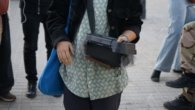La Vida de la Muerte, 2024 – Centre Cívic Guinardó
Opening on January 7 at 6.30pm
Death is a lived experience that marks our existence and conditions our lives. It manifests itself in the greatest pain that shows the limits of words. It collapses, paralyzes, leaves lifeless even to the living. This exhibition portrays an emotional state of displacement. Death separates us from those we miss, from reality and from ourselves. The work investigates the vacant place, where absence results in a presence and reveals itself in the desire for repetition. It also questions what existence means and whether it ends with death. The deaths of others are ours, we are the living who live them. We are what we incorporate from the other, we adapt the characteristics of those around us, which is why death is never singular. Others also internalize parts of us in them and in their stories, taking with them a part of who we are and what we have shared. With the death of others, we lose external references and pillars that make up our identity. Thus, in mourning the other, we mourn ourselves, as we actually experience our own deaths.
Karolina Adamczak is an artist born in Poland and raised in Ireland, currently living in Valencia. His work explores feelings and emotions, questioning the emotional label imposed by modern society. In 2021,
Karolina graduated in Fine Arts from the Institute of Art, Design and Technology in Dun Laoghaire, Dublin. He then practiced video and photography for a year with Paloma Muñoz at Sibèria Dansa in Barcelona. In 2023, he completed a master’s degree in Artistic Production at the Polytechnic University of Valencia.
https://www.karolinaadamczak.art/
Activity that accompanies the exhibition “The Life of Death”
Friday 31 January, at 6.30pm
Prior registration is required – Free activity
Activity description
Participatory activity that accompanies the exhibition La Vida de La Mort, focused on exploring death as a shared element in the construction of identity. It includes a talk on relevant academic texts, an open conversation in the style of Death Cafés and an introspective exercise in which participants answer questions about their connections and memories with other people. The initiative encourages collective reflection and understanding of death in relation to identity and personal relationships.
talk
A talk about the academic research of the authors who talk about death in the theoretical, historical and literary fields, whose texts have accompanied the development and research of the “The Life of Death” project. Featured texts include: Philippe Ariès, History of Death in the West, Ana Carrasco-Conde, Death in Common, Byung-Chul Han, Faces of Death, and Delphine Horvilleur, Living with Our Dead.
Conversation An open conversation with participants about the lived experience of death. The conversation would follow the style of the “Death Cafés”, where a specific topic on death is proposed and guests can share their thoughts and reflections on the topic.
Activity
Death in common and shared identity Linked with the exhibition, where the main idea explored is how death is not singular, as our identities are constructed by those around us.
In this exercise, the participants will deconstruct their identities and spaces through a series of questions that they will receive in written format, where they will be able to write their answers.
Some examples of questions include:
- What do you cook best? Have you ever cooked it for someone?
- Do you use a recipe that someone gave you?
- Have you adapted the way you cook because someone showed you a better way to do it and now you always do it that way?
- What is your favorite book? Have you recommended it to someone or has someone recommended it to you? What did this book bring to you and what do you think it brought to the other person?
- Is there a series you’ve watched or discussed with someone? What have been your reactions?
- Did someone play you a song that you loved? Did you put it on someone else later?
- What trips or excursions have you shared with others? What memories do you have associated with these people from these trips? What memories do you think others have of you on these trips?
- What is something you love to do, watch, or listen to when you’re alone that someone else taught you?







